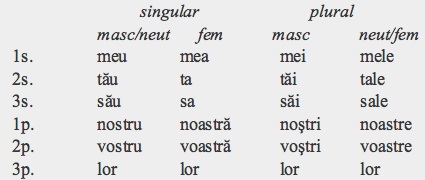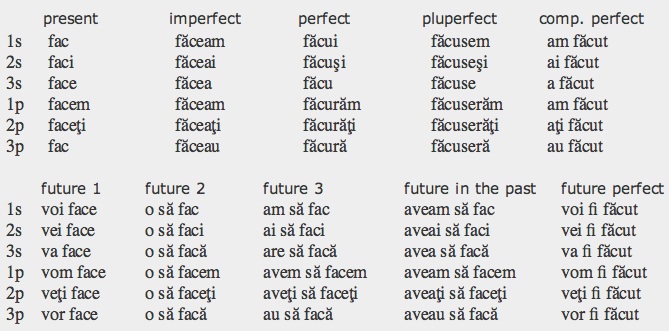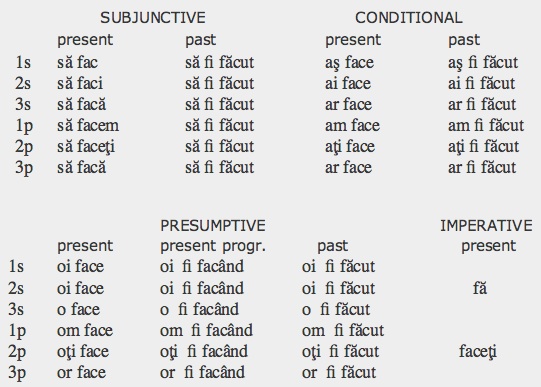An insatiable appetite for ancient and modern tongues


Alternative Names: Rumanian, Moldovan.
Classification: Indo-European, Italic, Romance.
Overview. Romanian is the only Balkan Romance language. It is a descendent of the Eastern Latin spoken in the Roman Province of Dacia by the Roman invaders and the assimilated local populations. The indigenous languages of the aregion (Dacian, Thracian and Illyrian) left no great trace in Romanian, but the Slavs who arrived towards 400 CE influenced its lexicon and syntax, a phenomenon deepened by its isolation from other Romance languages.
Distribution. Romanian is spoken in Romania and Moldova, in northern Greece, Albania, southern Serbia, Bulgaria and in the Istrian peninsula of Croatia. There are also many emigrants in Ukraine, Israel and some European countries.
Speakers. Close to 24 million people speak Romanian as a native language, including more than 90 % of the inhabitants of Romania and 73% of the inhabitants of Moldova. Their distribution by country is:
Romania
Moldova
Serbia
Ukraine
Israel
Greece
Albania
Bulgaria
20,000,000
2,700,000
250,000
250,000
250,000
55,000
10,000
10,000
Status: Romanian is the official language of Romania and Moldova. Though in the latter it is called Moldovan, Romanian and Moldovan are one and the same language. In the Autonomous Province of Vojvodina in Serbia, it is used for official purposes in some districts.
Varieties. The standard language is Daco-Romanian, spoken in Romania and Moldova. Other varieties of Romanian are Aromanian or Macedo-Romanian, spoken in northern Greece, Albania and southern Serbia, Megleno-Romanian, confined to small pockets north of Salonika in Greece, and Istro-Romanian spoken in the Istrian peninsula of Croatia. Due to its early separation, starting around the tenth century, mutual intelligibility between these dialects is comparatively low.
Oldest Document. It is a letter from Neacsu of Câmpulung, written in 1521, to the mayor of Brasov, warning him of the imminent attack of the Otomans.
Phonology
Vowels. Romanian has a symmetrical seven-vowel system. Besides, it has three diphthongs.
-
a) Monophthongs (7):

-
b) Diphthongs (3): ea, oa, eo.
Consonants (22). Romanian has 22 consonant phonemes which include 9 stops and affricates, 7 fricatives, 2 nasals, 2 liquids (a lateral and a trill), and 2 glides. Last-syllable consonants are palatalized before final i.

Stress: is free and not usually marked.
Script and Orthography
Romanian was written in Cyrillic from the appearance of the first texts in the language, at the beginning of the 16th century, until the late 19th century when it was replaced by the Latin alphabet. Three diacritics were added to the latter to represent additional sounds. The modern Romanian alphabet has 30 characters (below each one, is shown its equivalent in the International Phonetic Alphabet):















-
•â is reserved for the name of the country (România), its people and language.
-
•c + h is pronounced [k]; c + i/e is pronounced [tʃ].
-
•g + h is pronounced [g]; g + i/e is pronounced [dʒ].
-
•w is used for foreign words.
Morphology
-
Nominal. Nouns, adjectives and pronouns are inflected for gender and number, definiteness and case.
-
•gender: masculine, feminine, neuter.
-
•number: singular, plural. Plurals are usually marked with suffixes ending in -i or -e, sometimes accompanied with changes in the stem.
-
•definiteness: Romanian has an indefinite article that always precedes the noun and is written separately. It has also a definite article which, unusually among Indo-European languages, is postposed (placed after the word it modifies). Both articles are inflected in two cases (nominative-accusative and genitive-dative), three genders and two numbers:

-
For example: indefinite un om (a man), definite omul (the man).
-
•case: nominative-accusative, genitive-dative, vocative (rare).
-
Romanian, being more conservative than its Romance counterparts, has retained three cases. Only definite nouns (of all three genders) distinguish the two main cases in the singular and in the plural. The postposed definite article, rather than the noun itself, is the one declined. Neuter nouns are inflected like masculines in the singular and like feminines in the plural.
-
Indefinite masculine and neuter nouns are not inflected for case but this is shown in the indefinite article. Indefinite feminine nouns differentiate case only in the singular. The vocative is reserved for definite animates, especially humans, and proper names.

-
brown: definite article
-
•pronouns: personal, possessive, demonstrative, interrogative, indefinite, relative.

-
Personal pronouns have free and clitic forms which are inflected in the nominative, accusative and dative cases. In contrast with nouns, pronouns have different nominative and accusative forms. The accusative may be preceded by the preposition pe. Third person pronouns distinguish gender but the others do not.
-
Possessive adjectives distinguish gender and number of the possessed noun:

-
The 3s forms are seldom used, being replaced by the genitive of the 3rd person masculine (lui) and 3rd person feminine (ei) which don't distinguish neither gender nor number of the noun possessed. The 3p form is also the genitive of a personal pronoun.

-
Demonstrative pronouns recognize two deictic degrees, gender and number. They have formal and colloquial forms (listed first and second, respectively).
-
-
Some, but not all, interrogative pronouns and adverbs can function as relative pronouns: cine (‘who’), ce (‘what’), care (‘which’), cât (‘how much’).
-
Indefinite pronouns derive from the interrogative pronoun ce: ceva (‘something, anything’), altceva (‘something else, anything else’) and orice (‘anything, whatever’).
-
Verbal
-
•person and number: 1s, 2s, 3s; 1p, 2p, 3p.
-
•tense: present, imperfect, perfect and pluperfect are the basic tenses. The compound tenses include several forms of the future and the compound perfect.
-
The future has one literary form (future 1) and two colloquial ones (future 2 and future 3) besides a future in the past and a future perfect. The literary future and the future perfect use the auxiliary verb voi (‘to wish’). The two informal futures and the future in the past are also periphrastic but use other auxiliaries combined with the present subjunctive.
-
There are, at least, four conjugations. The conjugation of the verb face (‘to do’), belonging to the 3rd conjugation, in the indicative mood is:

-
The compound tenses are formed as follows:
-
‣compound perfect: present avea (‘have’) (short form) + past participle of verb.
-
‣future 1 (literary): present voi (‘wish’) + infinitive of verb.
-
‣future 2 (spoken): invariable particle o + present subjunctive of verb.
-
‣future 3 (spoken): present avea + present subjunctive of verb.
-
‣future in the past: imperfect avea + present subjunctive of verb.
-
‣future perfect: present voi + infinitive fi (‘to be’) + past participle of verb.
-
The negative of all future forms is done by placing nu before the conjugated verb.
-
The present has no progressive forms and, thus, corresponds both to the present indefinite and present continuous of English.
-
The imperfect expresses an habitual or progressive action in the past.
-
The simple perfect is not frequent; it is used for a recently completed action to denote surprise or to achieve a comic effect.
-
The pluperfect indicates that a past action was completed before another past action.
-
The compound perfect signals that an action has been completed and is comparable to the past indefinite or present perfect of English.
-
Futures 1, 2 and 3 are equivalent but differ in their degree of formality; future 1 is literary and administrative, future 2 is preferred in standard speech, future 3 is used in informal situations.
-
The future perfect indicates a future action completed before another future action. The future in the past indicates that an action was completed in the past after another past action.
-
•mood: indicative (all tenses), subjunctive (present and past), conditional (present and past), presumptive (present, present progressive and past), imperative (present).
-
The subjunctive, conditional and presumptive tenses are compounded with specific particles. The subordinate particle să is invariable. The conditional and presumptive particles are inflected for person and number.

-
These non-indicative tenses are formed as follows:
-
‣subjunctive present: subordinate particle să + conjugated verb.
-
‣subjunctive past: subordinate particle să + infinitive fi (‘to be’) + past participle of verb. It has only one form for all persons and numbers.
-
‣conditional present: conditional particles + infinitive of verb.
-
‣conditional past: conditional particles + infinitive fi + past participle of verb.
-
‣presumptive present: presumptive particles + infinitive of verb.
-
‣presumptive present progressive: presumptive particles + infinitive fi + gerund of verb.
-
‣presumptive past: presumptive particles + infinitive fi + past participle of verb.
-
‣imperative: 2nd sg = 2nd sg or 3rd sg present indicative, or irregular; 2nd pl = 2nd pl. present indicative
-
The present subjunctive expresses that an action is possible, that it might happen in the future or that it is only an imaginary or virtual action. Thus, it is used, generally, after a main verb expressing wish, possibility, permission, request, etc. The past subjunctive is used after the past conditional or to regret a past action.
-
The present conditional expresses a wish or intention at the moment of speaking as well as a condition required for an action. The past conditional expresses a past unfulfilled action.
-
The present presumptive expresses a supposition or hypothesis at the moment of speaking, and the past presumptive a supposition about a past event. The present progressive of this same mood makes a supposition about an action that might be happening now.
-
•voice: active, reflexive, passive.
-
•non-finite forms: infinitive (past and present), past participle, gerund, supine.
-
present infinitive: a face
-
past infinitive: a fi făcut
-
gerund: facând
-
past participle: făcut
-
supine: de făcut
-
The supine is identical in form to the past participle but preceded by the preposition de. It functions as a verbal noun, similar in some respects to the infinitive and the English gerund, sometimes denoting obligation, necessity or purpose.
Syntax
The basic order is Subject-Object-Verb (SVO) but OVS is also quite frequent. Personal pronouns can be dropped. Indefinite determiners precede nouns while adjectives follow them. Adjectives agree with their nouns in gender, number and case. Some syntactical features of Romanian are the result of Balkan influence such as the use of a periphrastic future, suffixal definite markers and scant predilection for the infinitive.
Lexicon
Slavic languages are the main source of loanwords. Greek borrowings are also abundant, transmitted directly or indirectly through Slavic. Romanian has a small percentage of Turkish-derived words, as well. From the 19th century many French words entered Romanian vocabulary in an effort to reduce the Slavic element. Recently, a number of English terms have been imported.
Basic Vocabulary
one: unu
two: doi
three: trei
four: patru
five: cinci
six: şase
seven: şapte
eight: opt
nine: novă
ten: zece
hundred: sută
father: tată
mother: mamă
brother: frate
sister: soră
son: fiu
daughter: fiică
head: cap
face: faţă
eye: ochi
hand: mână
foot: picior
heart: cord, inimă
tongue: limbă
Key Literary Works (forthcoming)
-
© 2013 Alejandro Gutman and Beatriz Avanzati
Further Reading
-
-'Rumanian'. G. Mallinson. In The World's Major Languages. B. Comrie (ed), 253-268. Routledge (2009).
-
-Colloquial Romanian. D. Deletant. Routledge (1983).
-
-Romanian Grammar. D. Cojocaru. SEELRC (2003).
-
-Brève Histoire de la Langue Roumaine des Origines à Nos Jours. A. Rosetti. De Gruyter Mouton (1973).
Romanian

Address comments and questions to: gutman37@yahoo.com
MAIN LANGUAGE FAMILIES
LANGUAGE AREAS
Languages of Ethiopia & Eritrea
LANGUAGES by COUNTRY
LANGUAGE MAPS
-
• America
-
• Asia
-
Countries & Regions
-
-
Families
-
• Europe
-
• Oceania
